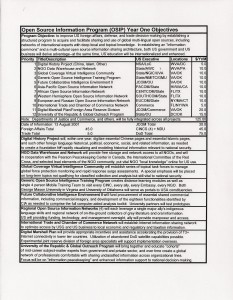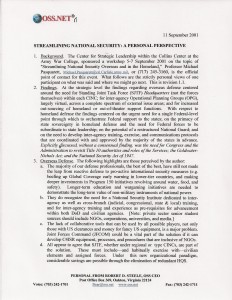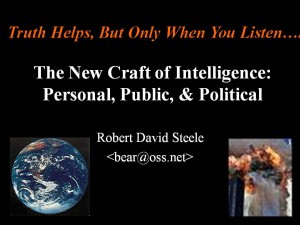There is no question but that the Attack on America of 11 September 2001 has awakened and even frightened the American public. It has elicited conventional assurances from other nation states. What most Americans do not understand, what this book makes brilliantly clear, is that two thirds of the rest of the world is glad it happened. I quote from page 52: “…at least two-thirds of the world's people–Chinese, Russians, Indians, Arabs, Muslims, and Africans–see the United States as the single greatest threat to their societies. They do not regard America as a military threat but as a menace to their integrity, autonomy, prosperity and freedom of action.”
Whether one agrees with their depiction of two-thirds or not (or whether they see the Attack as a well-deserved bloody nose or an atrocity beyond the pale), the fact is that the authors paint–together with the PIOOM map–a compelling picture of billions–not millions but billions–of impoverished dispossessed people suffering from failed states, crime, slavery, starvation, water shortages–and an abundance of media as well as propaganda showing the US fat and happy and living the consumer society dream on the backs of these billions.
Of all the policy people I have followed over the years, Robert McNamara and Bill Colby are the two that have in my view matured and broadened the most after leaving the halls of power. The deep insights that I find throughout this book-a partnership expert between McNamara with the global reality and power game insights, James Blight with the scholarly underpinnings-are extraordinarily applicable to the challenges that we face in the aftermath of the 11 September 2001 Attack on America. In particular, their dissection of the United Nations-what works and what does not-and their recommendations for future initiatives that are multilateralist and focused on the prevention and amelioration of the root conditions that are spawning our terrorist challenges, are vital reading for policymakers, diplomats, warriors, and financial magnates.
Memorandum: Streamling National Security
MemorandaReview: Fitzroy Dearborn Book of World Rankings, 4th Edition
4 Star, Atlases & State of the WorldReview: Orbiting the Giant Hairball–A Corporate Fool’s Guide to Surviving with Grace
4 Star, Change & Innovation, Consciousness & Social IQ
![]() Over the Top on Cute, Profound Insights, No Solutions
Over the Top on Cute, Profound Insights, No Solutions
September 4, 2001
Gordon MacKenzieI would never have bought this book off the shelf, because it is way over the top with cutesy child-like drawings, hard to read type, and other affectations–it goes beyond charming toward excessive cosmetics. It was, however, recommended by someone I trust, and I am glad I read it.
The two most profound insights, insights every teacher and CEO should be required to repeat every day, are that our schools beat creativity out of our children, and our corporations suppress individual ideas and any attempts at diversity.
I read this book twice. The first time, like a cat circling a mouse, I would pick it up and read just one of the stories, expecting to collect enough evidence to discard it completely, and instead being drawn back for another story at random. The second time, more sequentially, looking for the meat to review.
Unfortunately, absent a major revolution in how we manage our organizations, this book does not suggest solutions. Very few can survive on their own unless they are willing to drop down to subsistence living. The sad fact is we have a school system designed over 100 years to deskill people to the point they could work in assembly line jobs (including white collar “company man go along” jobs), and in the same 100 years have focused on building companies in which everyone is replaceable, and no one person can hope to do the business development, product development, service, and billing for any given offering.
Certainly the Internet offers some prospects–say 20 years down the road–for networks of “virtual corporations” to take effect, but in the meantime, I have to judge this book as a really excellent pate de foie gras, just the thing with which to torment the corporate slaves who want to dream of freedom.
Great book, something we can use in another 40 years or so, if we have managed to get a grip on campaign finance reform, neighborhood cottage and networked industries, and radically restructured schools that get away from rote and celebrate the process of learning. Until then, most people are going to have to focus on keeping the job they have, however distasteful it may be, because the harsh reality is that in this day and age, it is the large inefficient organization that provides gainful employment for the majority of us that have not been schooled to be anything other than drones.
I'll end on a positive note: there is something called the Davies J-Curve, a political science finding that suggests that people do not revolt to acquire greater freedom or anything else, but rather when they have experienced all that they wish, and then it is taken away from them. If we have a major recession that decapitates government and cleans out a good third of the small businesses and corporations that are hanging on by a string now, it may just inspire groups of people to revisit how they relate to one another.
One more positive note: if you are a realist, and you know that you have to accept drone status, but want to be cheered up and contemplate little ways around the margins where you can exercise some freedom muscles, this is the book for you. I enjoyed reading this book, and it may be unfair to evaluate it at the strategic level-there is no question that the author is an inspired original thinker, and I hope the day comes when he is the norm, rather than the exception.

Memorandum: One-Page Initial Operating Capability (IOC) for a National Open Source Program (NOSP) as Delivered to the Senate Armed Service Committee (SASC)
Budgets & Funding, MemorandaDuring the August recess this got in to several SASC staff that were contemplating an OSINT initiative. Don Gessman provided the recommended breakdown including an earmarked amount for inter-agency OSINT. The Department of Defense and the Combatant Commands have always been the central organizing base for a national OSINT program, which would be funded by non-reimbursable defense allocation.
Below add up to $125M at Initial Operating Capability (IOC). See the separate Memorandum on a $2B a year Full Operating Capability (FOC) centered on Defense but inclusive of Whole of Government planning, programming, budgeting, and campaigning (PPBC).

Review: Killing Pablo–The Hunt for the World’s Greatest Outlaw
5 Star, Empire, Sorrows, Hubris, Blowback, Intelligence (Government/Secret), Military & Pentagon Power, Secrecy & Politics of Secrecy, War & Face of Battle
Mark Bowden
5.0 out of 5 stars Reveals US Sources & Methods, Weaknesses
July 25, 2001
Robert D. Steele (Oakton, VA United States) – See all my reviews
I remember being shocked when a book published by a former prisoner of war revealed all of the CIA's sources and methods for secret writing–one reason terrorists and others make photo-copies of incoming and outgoing correspondence these days….
This book provides an excellent overview of sensitive sources and methods used by the U.S. military to intercept and locate electronic transmissions. It specifically “blows” a cover company, two specific kinds of aircraft, and several U.S. Special Operations Forces standard operating procedures. I suspect that NSA and the CIA Centers dealing with terrorism and with crime and narcotics are having the same difficulties recovering from this book that NSA had when President Reagan inadvertently revealed in public that he was receiving transcripts of Politburo cell phone conversations made while in transit, from their car phones.
Having said that, I find that the author has performed very responsibly as an investigative journalist, and that his story is superior in every respect. I even find that he has withheld some key information out of respect for his sources,and that there are many lessons to be learned from this book about how we might improve our transnational campaign against non-state forces that have vastly more money, ruthlessness, and sheer people power than we do.
I like and recommend this book–it is a real-world story, well-researched and well-told.








